The counter 枚 (まい/mai) is perhaps one of the most common Japanese counters. Much like the counter つ or 個, it was originally used to count general things. Now, barring a few exceptions, it's mainly used to count flat objects.
According to the How to Count Dictionary (数え方の辞典), there are only four different categories of countable things that use 枚 as their counter. When compared to the counter 本, that's a huge relief! You should have no problem with this one.
- Pronunciation of Japanese Counter 枚
- "Flat" Things
- Positions or Roles
- Sections or Parts
- Food Orders
- And Now for Our Seven Pieces of Gyōza…
Prerequisite: If you're completely new to Japanese counters, we recommend you learn the basics first. Make sure you know how to read hiragana and katakana. We'll mention the "kango/wago/gairaigo counting method," and you can learn about all three of these Japanese numbering systems in our Counting in Japanese article. Knowing the kanji for numbers will help, too. In our example sentences and explanations, we equally use Arabic numerals (1, 2, 3) and Japanese kanji (一, 二, 三), since both are quite common in Japanese.
Pronunciation of Japanese Counter 枚
Pronunciation when counting with 枚 is easy. Unlike some counters, nothing really changes: "one" is just いち (and not いっ). 枚's pronunciation never changes, either. It's just [number] + [枚]. Here's a chart for your perusal.
| Numeral | Japanese | Reading 1 | |
|---|---|---|---|
| 1 | 一枚 | いちまい | |
| 2 | 二枚 | にまい | |
| 3 | 三枚 | さんまい | |
| 4 | 四枚 | よんまい | |
| 5 | 五枚 | ごまい | |
| 6 | 六枚 | ろくまい | |
| 7 | 七枚 | ななまい (しちまい) | |
| 8 | 八枚 | はちまい | |
| 9 | 九枚 | きゅうまい | |
| 10 | 十枚 | じゅうまい | |
| 11 | 十一枚 | じゅういちまい | |
| 12 | 十二枚 | じゅうにまい | |
| 100 | 百枚 | ひゃくまい | |
| 1,000 | 千枚 | せんまい | |
| 10,000 | 一万枚 | いちまんまい | |
| how many | 何枚 | なんまい |
Let's start learning about the things that the Japanese counter mai counts!
"Flat" Things
We could give you a hundred pages listing the flat, square-shaped things that 枚 counts.
Counting "nicely shaped flat things" is the most common use case for 枚. That sounds simple, but it turns out there are a lot of flat things out there. So let's break this category down into a handful of subcategories. Don't worry: they're all flat, and reading through all of them will give you a good framework to help you know when to use 枚—even if it's for an object you've never seen counted before!
Square(ish) and Flat

Signs, blackboards, doors, cutting boards, drywall, regular walls, floors, tatami mats, bath mats, entranceway mats, picnic mats, roofs, windows, window panes, door plates, planks… get the idea? We could give you a hundred pages listing the flat, square-shaped things that 枚 counts.
- トーフグの広告看板を三十枚注文した。
- We ordered thirty Tofugu billboards.
- クリスマスにサンタクロースからまな板を三枚もらった。
- Santa Claus gave me three cutting boards for Christmas.
- コウイチの投げたボールで、窓ガラスが一枚割れてしまった。
- The ball Koichi threw broke a window pane.
- 石膏ボード五枚あれば足りると思う?
- Do you think five sheets of drywall will be enough?
- 部屋の大きさに合わせて作られるため、畳のサイズは1枚1枚微妙に違う。
- The size of each tatami mat varies slightly, as they're made to fit each room.
- ござ四枚とレジャーシート二枚がトランクに積んであるよ。
- There are four straw mats and two picnic sheets in the car trunk.
But there's a common exception. Flat-panel TVs, iPads and other tablets, and smartphones are all flat and board-shaped, right? Yet one counts these using 台 (だい), the counter for "machines." If you happened to work in the factory that made these devices, you'd still count the glass and screen panels with 枚. But once it's all put together and becomes a whole device, it changes to 台.
From picnic sheets to rugs to carpets to bath mats to straw mats to floor mats to curtains to bed sheets, any kind of sheet-shaped thing are counted with 枚.
What about pillowcases or cushion covers? When you are not using them, they are flat, so they too are counted with 枚.
Round(ish) and Flat

Plates and dishes—those that aren't bowls—are also counted using 枚. Other flat, round things, including CDs/DVDs, contact lenses, and pancakes, are, too.
- 五枚セットのお皿を買いました。
- I bought a set of five plates.
- 今お財布には、百円玉三枚と、十円玉四枚しか入っていない。
- There are only three ¥100 coins and four ¥10 coins in my wallet right now.
- コウイチがAKB48のCDを244枚もアマゾンでポチったのを見た。
- I saw that Koichi bought two hundred forty-four AKB48 CDs on Amazon.
- どうしてETのDVDを二枚持ってるの?
- Why do you have two E.T. DVDs?
- カラコンなんて、一枚も持ってないよ。
- I don't have any colored contact lenses.
- 朝ごはんにクッキーを八十五枚食べたせいで、気分が悪いんだ。
- I ate eighty-five cookies for breakfast, so I'm not feeling well.
- マイケルは、スーパーマリオのお面を何枚持っているでしょう?
- How many Super Mario masks do you think Michael owns?
You may have noticed we mentioned "round(ish) flat things" and "square(ish) flat things." Why not just say flat things in general? We could, but it feels more like 枚 is used to count properly-shaped things. For example, in the next section you'll see that random, ripped pieces of paper don't get counted with 枚. Neat, manufactured squares and circles have a much higher chance of getting counted with 枚. Flat triangles, too, since they have a decided shape.
Paper
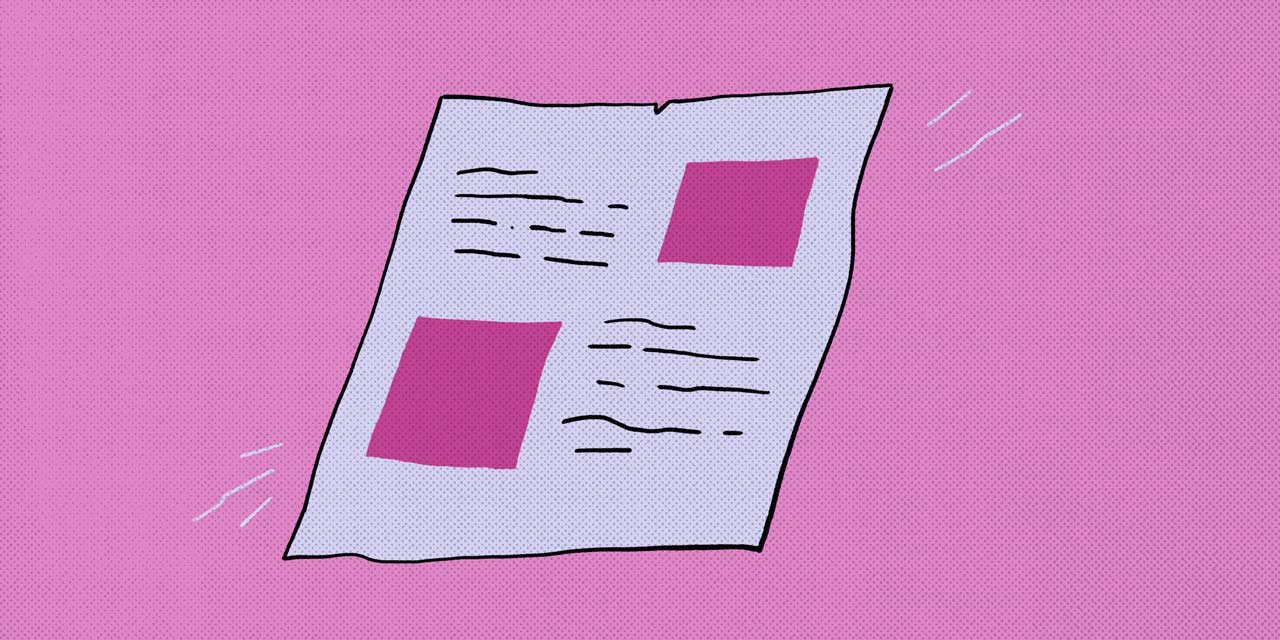
Paper can be any shape at all, of course, and it's all flat. It goes without saying that paper is counted with 枚—paper from notebooks, newspapers, magazines, manuscripts, origami, cash money, and more. But what about ripped pieces of paper? These don't count with 枚, unless they're ripped into a neat rectangle or round shape. In that case, you would use the Japanese counter for "pieces," which is 片 (へん).
- その包装紙、一枚余ってない?
- Don't you have an extra sheet of that wrapping paper?
- 300枚以上の分厚いノートを探しています。
- I'm looking for a thick notebook that has three hundred or more sheets.
- コウイチはAKB48の握手券を244枚持っている。
- Koichi has two hundred forty-four AKB48 meet-and-greet handshake tickets.
- 1万円札を千円札十枚に両替してください。
- Can you exchange one ¥10,000 bill for ten ¥1,000 bills, please?
But what about ripped pieces of paper? These don't count with 枚, unless they're ripped into a neat rectangle or round shape.
Besides plain blank paper, cards and card-shaped things are included, too. Postcards, playing cards, business cards, credit cards, photos—even your Magic cards all fit this category.
What if these items are digital? They're still counted with 枚. This includes your digital photographs and Hearthstone cards from the video game.
Illustrations, Pictures, Paintings, Etc.
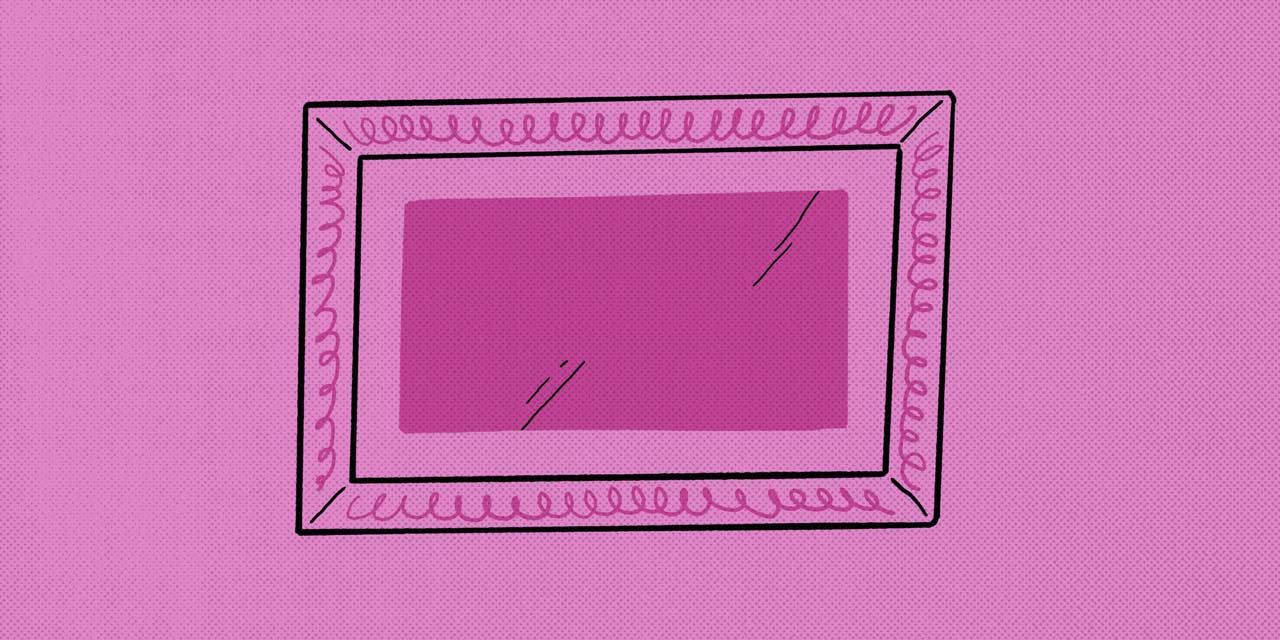
Works of art created on paper or painted on a canvas are counted using 枚, although if you just want to generally count a certain number of artworks—in a gallery or exhibition, say—you can use the counter for "items," which is 点 (てん). Wall paintings and murals also don't make the cut for 枚; they're counted with 面 (めん), the counter for surfaces.
- その絵を一枚売ってくれませんか。
- Could you sell one of those paintings to me, please?
- アヤは毎日何枚ぐらい絵を描くの?
- About how many illustrations do you draw a day, Aya?
What if you're counting 3D artwork made on a flat canvas? If it's part of the canvas, we'd suggest counting it as 枚; if it really rises off the canvas, consider switching to 点.
- 葉書三枚で1ポンドだって。
- It says three postcards for one pound.
- トランプって全部で何枚だっけ?
- How many cards total are in a deck of cards?
- クレジットカード、一枚も持ってないの?
- Don't you have even one credit card?
- スマホの子供の写真、気づいたら5千枚超えてた。
- Before I knew it, I took over five thousand photos of my kid with my smartphone.
Note that in old Japanese novels, characters may refer to photographs and postcards using the counter 葉 (よう). Nowadays, however, it's considered archaic.
Cloth and Fabric

It goes without saying that cloth and fabric are flat. Towels, handkerchiefs, hachimaki, scarves, as well as the fabric used to make those things—all are counted with 枚. That being said…
- トーフグストアで手ぬぐいを六枚買った。
- I bought six tenugui from the Tofugu store.
Sleeping bags exist in a kind of gray area. If they're flat and laid out, you could use either 枚 or 個 (こ), which is a general counter for "things."
…there are a few exceptions when it comes to fabric. When it's really long and skinny, it can also be counted with 本 (ほん), the counter for long skinny things. When you're working with many different shapes and types of fabric (say, for example, you're sewing a patchwork quilt), you would use the counter for slices: 切れ (きれ).
Fabric turns into clothes, of course, which for the most part are counted with 枚. Did you add three T-shirts to your online shopping cart? Then you have 3枚 T-shirts. Kimono, shirts, pants, skirts, dresses, coats, jackets, and… pretty much any clothing types are included. That is… until it gets thick. Don't count a big, puffy down jacket using 枚; instead, use the counter for clothes, which is 着 (ちゃく). For clothes, these two counters are essentially interchangeable.
- 気に入ったTシャツは、必ず二枚買うようにしています。
- I always buy two of the same T-shirt if I find one I like.
- 結局セールでジャケット一枚しか買わなかった。
- After all, I only bought one jacket at the sale.
- 私、スカートってあんまり履かないから、三枚しか持ってないの。
- I usually don't wear skirts, so I only have three of them.
Now it gets a little more complicated. Did you know there are rolls of kimono fabric that are a set size? These are counted as 反 (たん). When this fabric is two 反s, the counter changes to 匹 (ひき), which is mainly used to count smallish animals.
What about things made with bigger pieces of fabric? Sheets, comforters, blankets, pillowcases, cushion covers, and other bedding? They're all counted with 枚!
- その引き出しの中にベッドシーツが三枚入ってるはずだよ。
- There should be three bed sheets in that drawer.
- 枕カバー、あと何枚必要かな?
- How many more pillowcases do you think we need?
Beyond thin sheets, 枚 also applies to mattresses and futons, even though they're pretty thick. This may be due to their relative thickness given their size. There are a lot of big, flat things in the world!
- キングサイズのベッドのマットレスって、一枚いくらぐらいするのかな。
- I wonder how much a king-sized mattress usually costs.
Sleeping bags exist in a kind of gray area. If they're flat and laid out, you could use either 枚 or 個 (こ), which is a general counter for "things." Rolled up, you'd definitely use 個.
What about other pieces of cloth, both big and small? What about curtains, rugs, and carpets? 枚.
Film Material or Similar Things
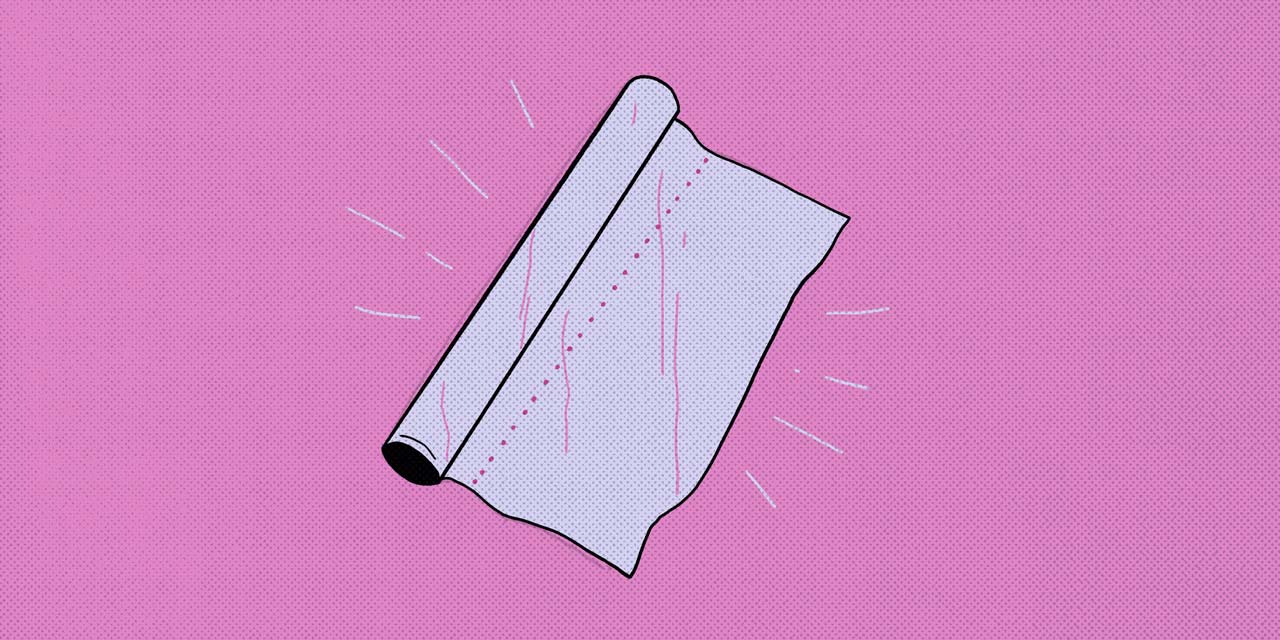
You may already know that rolled-up things, like plastic wrap, aluminum foil, Scotch tape, and so on, get counted with the "long cylinder-shaped things" counter 本, or the counter ロール. When you unravel them, though, and take sheets or pieces off, they become flat and square-ish. Thus you can count them with the counter 枚. Make sense?
- シール三枚でこの値段は高くない?
- Isn’t this expensive for just three stickers?
- 破れたところに、セロテープを二枚貼って補強しておいた。
- I put two pieces of tape over the torn part to reinforce it.
- サランラップ一枚取ってくれない?
- Can you get me a sheet of plastic wrap?
Speaking of plastic wrap, what about plastic bags? If you're using them as bags, you'd count them with the 袋 (ふくろ) counter. But if they were in a pile and flattened out, count them with 枚. If the bag was rolled or folded up, count them as a general thing using the counter 個.
Non-Shoe-Like Shoe Things
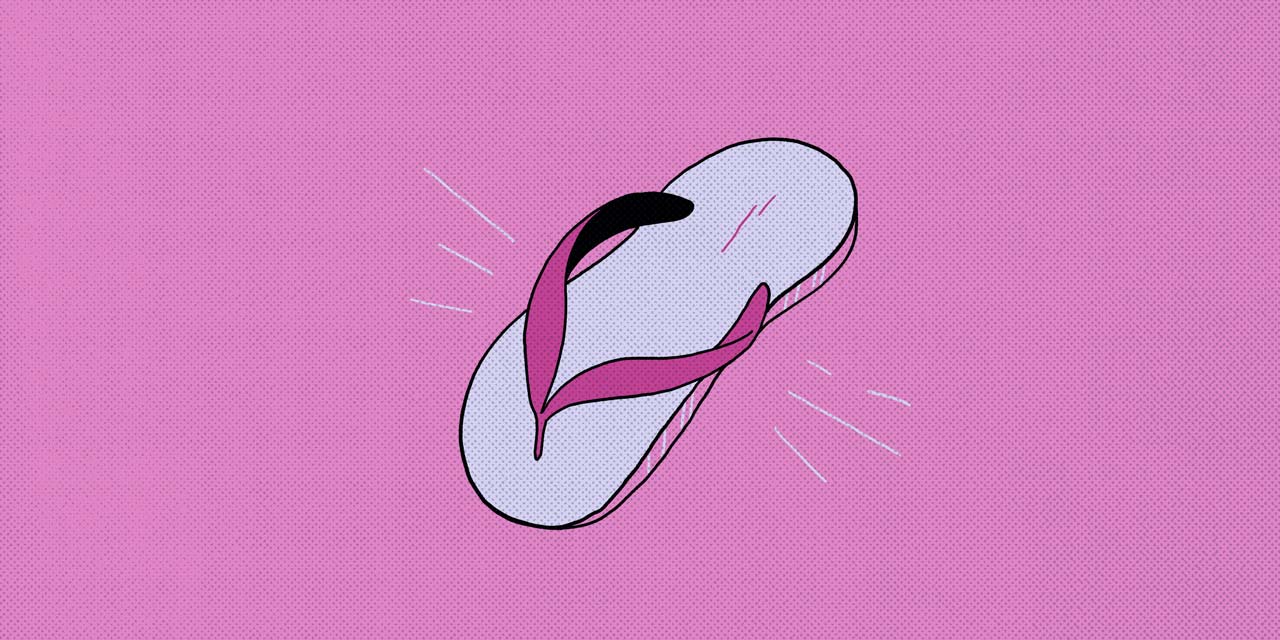
Lastly, besides shoes or boots, how do you count the things you put on your feet? Flip-flops, socks, zōri, and sandals are counted with 枚… though if you're counting them in pairs, use the "pairs of shoes/socks" counter 足 (そく) instead.
What about house slippers? They're common in Japan, and we need a way to count them. For the really flat, cheap, disposable ones, we suggest counting them using 枚. But if it's a regular-sized slipper, consider using 個. If it's a pair, use 足.
- 道路にピンク色のサンダルが一枚だけ落ちていた。
- There was only one pink flip-flop left on the road.
With that, we've reached the end of the first 枚 category, "nicely shaped flat stuff." It's by far the most common and useful category for this counter, and if you were to stop right here, you'll probably be fine 99% of the time. Still, there are more ways to use 枚, so let's go over them now.
Positions or Roles
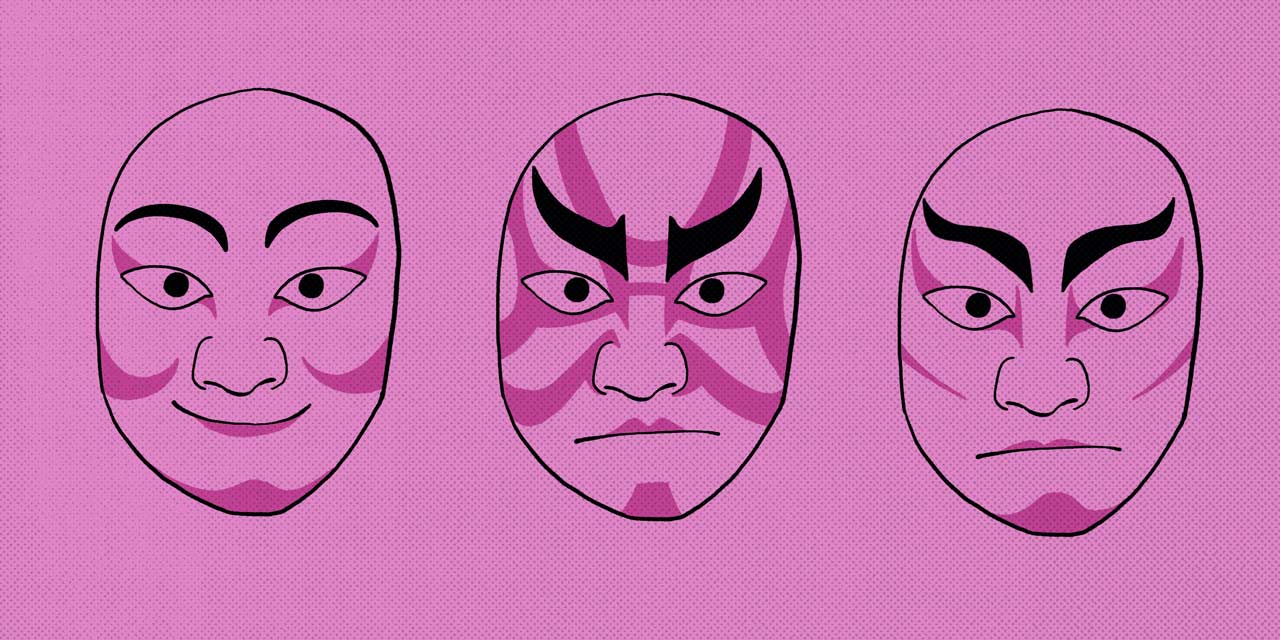
You won't see it much these days, but 枚 used to be used to count positions and roles. The counter that does that now is 役 (やく), but you may still see 枚 in older texts.
The only time you'll see it being used this way now is in idiomatic expression. Here's one example. The phrase 一枚噛む (いちまいかむ) literally means "bite the role." Figuratively it means "to get involved." Another phrase, 二枚肩 (にまいがた) refers to two men carrying a kago (a Japanese palanquin). In modern times, this means "two people who have an important role in an organization."
- ワニカニ乗っ取り計画には、トランプ大統領が一枚噛んでいる。
- President Trump is involved in the WaniKani takeover plan.
Kabuki actors are also counted using 枚 because, back in the day, their faces were painted outside the theater on a signboards—which, you remember, are counted with 枚. The first signboard would have the main character; the second was a secondary character who was a handsome man; the third was the clown/funny role. In Japan nowadays, a handsome man is called 二枚目 (にまいめ), and a funny—but maybe not so good-looking—guy is 三枚目 (さんまいめ).
- 私、ザ・二枚目って感じの人って苦手なのよ。
- I'm not a fan of men who are like THE Mr. Handsome.
Finally, if you're into sumo, you might have seen 枚 used for ranking the wrestlers. Besides Yokozuna, Ozeki, Sekiwake, and Komusubi, all other positions are counted with 枚.
- コウイチ関は、あと二枚で幕内昇進だね。
- Kōichi-zeki is gonna enter the makūchi sumo division just by moving up two more ranks, huh?
Sections or Parts
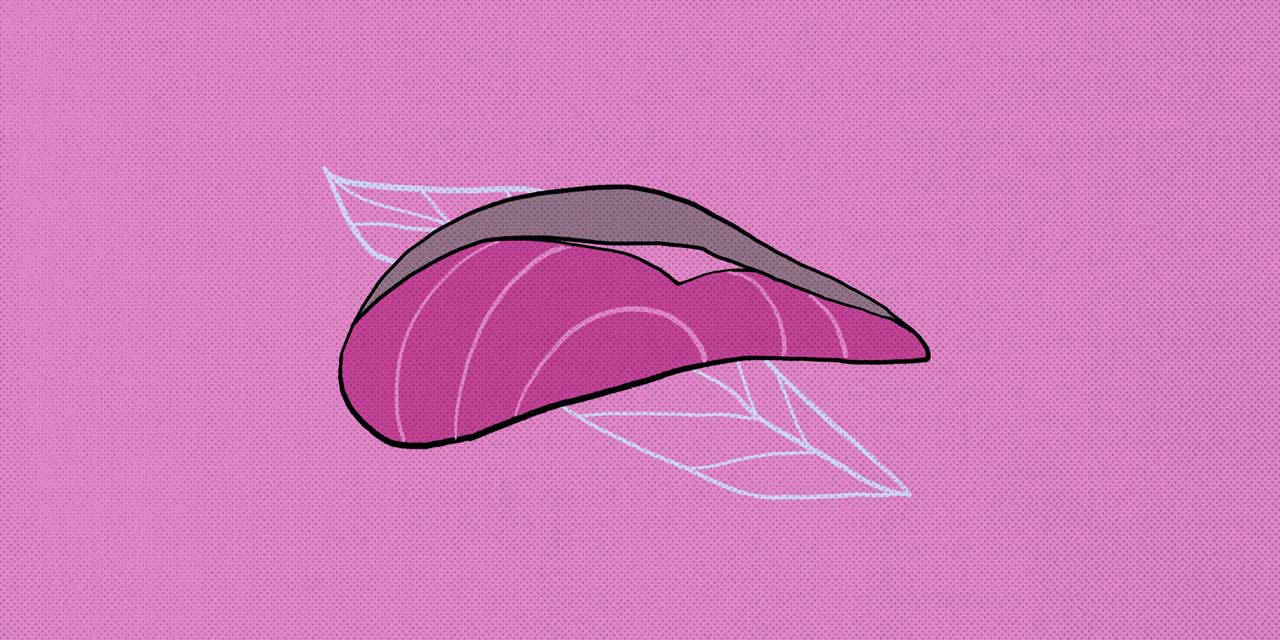
The most useful and common use of the counter is with fish. Remember, this is Japan we're talking about, and there are lots of fish. Fillets of fish get counted using 枚.
- 魚を三枚におろせますか?
- Can you fillet fish into three pieces?
That being said, if the pieces aren't flat—maybe they're cut into cubes for poké—we wouldn't suggest using 枚; instead, use 個. For sashimi pieces in particular, count them using 柵 or 冊 (both さく).
Continuing with the idea of dividing things into sections, be aware that farm fields or rice paddies can be counted with 枚. But if we're talking about plots of land, lots, blocks, or other similar divisions, use 区画 (くかく) instead.
Food Orders
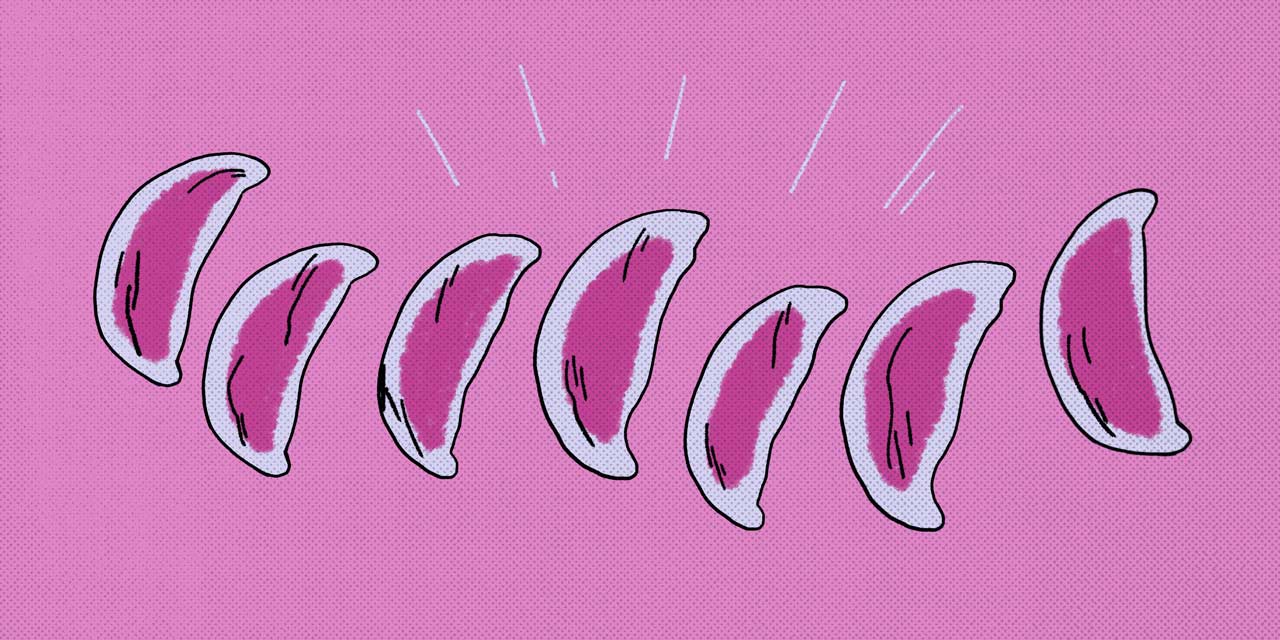
A single serving of gyōza or soba noodles gets counted with 枚.
Finally, the last category for the 枚 counter starts with a story. A long time ago, 枚 was used to count food orders. People think this is because they were counting plates of food. As you might remember, plates are counted with 枚 because they're flat and square/round. Later, orders were counted with 丁 (ちょう). But now orders get counted with just the regular Xつ or 個 "thing" counters.
Although the 枚 usage is considered archaic, a couple exceptions have made their way into modern times. A single serving of gyōza or soba noodles gets counted with 枚. The amount of soba noodles you'd get for 一枚 varies from restaurant to restaurant, but you can rest easy knowing that 一枚 is generally seven pieces of gyōza: the perfect amount, don't you think?
- ランチにざる蕎麦を三枚も食べた。
- I ate three portions of zarusoba.
- 餃子は焼き立てが美味しいから、一枚ずつ頼んだ方がいいよ。
- Gyōza is delicious when it's freshly cooked, so you should order one serving at a time.
And Now for Our Seven Pieces of Gyōza…
As you can now see, the first category of 枚 is infinitely more useful than the other three, but perhaps a few specific idiomatic use cases will prove valuable.
Hopefully, by reading through this guide, you now have a good framework for what is counted with 枚 and what isn't. Don't worry if you make a mistake; counters have some flexibility, and people will know what you're talking about as long as the counter mostly makes sense.
When you're ready for more, we have plenty of other counter articles you can go through, including our big Japanese counters guide. If you're looking for a specific suggestion, the counters 本 and 台 are pretty important to learn about. I wonder what counter we should use to count counter articles? 🤔
-
Cells with multiple entries divided by a
/indicate multiple pronunciations that are equally common. Cells with entries in parentheses indicate that the parenthesized word is an uncommon or archaic pronunciation. ↩
